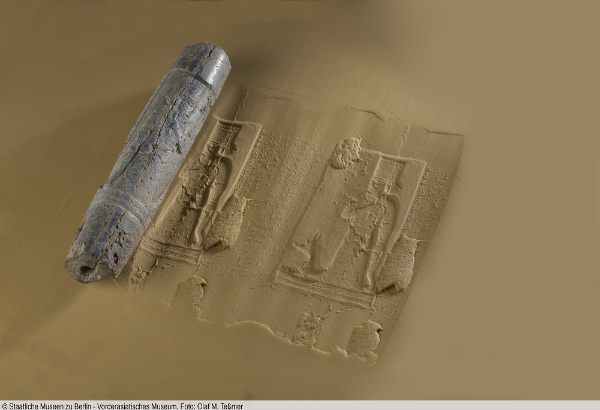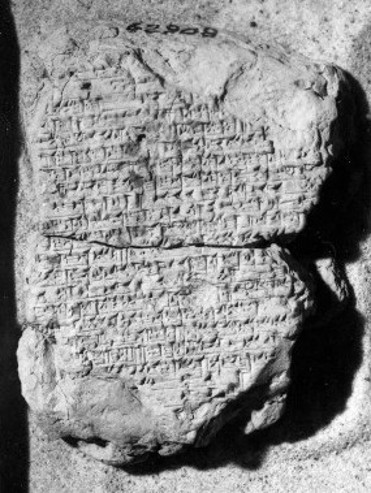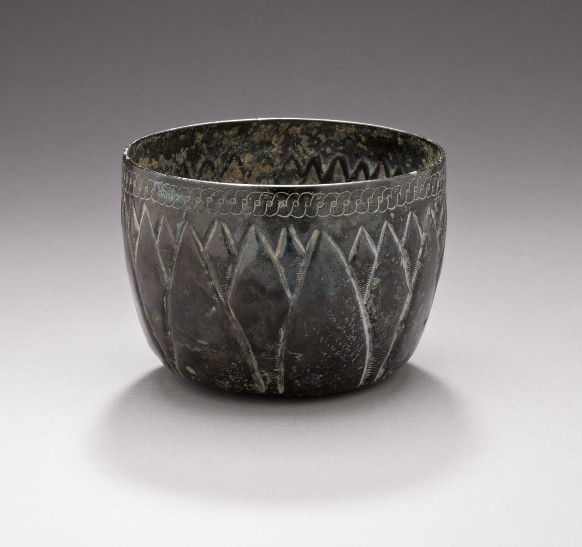Inscriptions
Marduk-zākir-šumi I 1 Marduk-zākir-šumi I 2 Marduk-zākir-šumi I 2001

Lapis lazuli cylinder seal of Marduk-zakir-šumi I of Babylon (ca. 851-824 BC), depicting the god Marduk and his snake-dragon. From Babylon. VA Bab 646, Vorderasiatisches Museum Berlin - Staatliche Museen zu Berlin. Photograph by Olaf M. Teßmer (CC-BY-NC-SA 3.0 DE), from Edition Topoi (DOI: 10.17171/1-5-3692-6).
This inscription is written on a lapis lazuli cylinder seal measuring 19x3.5 cm. The seal was found by the German excavators on the tell of Amran-ibn-Ali in Babylon, and precisely inside a basket filled with precious stones stored in room E of a Parthian building located there. According to the inscription the object was originally manufactured also with red gold, probably used for fittings at either end.
The seal bears the depiction of the statue of god Marduk standing on its pedestal facing the right. The god, represented wearing a high headgear, a long robe and ornaments with astral symbols, holds in his left hand the measuring rope and the rod, insignia of the justice, and is accompanied at his feet by the mušḫuššu, the snake-dragon that constitutes his symbol animal.
The Akkadian inscription, organized in eight lines perpendicular to the representation, reports the dedication of the seal to the god Marduk by the king Marduk-zākir-šumi. The offer, as stated in the text, was made in order to obtain the divine favor, resulting primarily in a good health, a long life and a secure throne, and was presented most probably to the god Marduk in Esagila, his main temple in Babylon located just below the tell of Amran-ibn-Ali, to be fitted on a cord or a chain around the neck of his cult statue.
Access the composite text [http://oracc.museum.upenn.edu/ribo/babylon6/Q006295] of Marduk-zākir-šumi I 1.
Source
Bibliography
- Delitzsch 1900 [http://oracc.museum.upenn.edu/ribo/babylon6/bibliography/index.html#delitzsch1900], pp. 13-15 (translation)
- Weißbach 1903 [http://oracc.museum.upenn.edu/ribo/babylon6/bibliography/index.html#weissbach1903], no. 6 (edition)
- Frame 1995 [http://oracc.museum.upenn.edu/ribo/babylon6/bibliography/index.html#frame1995], pp. 104-105 (edition)
- Meyer 1962 [http://oracc.museum.upenn.edu/ribo/babylon6/bibliography/index.html#meyer1962], pp. 104 (translation)
- BRost and Marzahn 1983 [http://oracc.museum.upenn.edu/ribo/babylon6/bibliography/index.html#rostandmarzahn1983], p. 27 (translation)
- Wittmann 1992 [http://oracc.museum.upenn.edu/ribo/babylon6/bibliography/index.html#wittmann1992], p. 262 no. 61 (edition)
- Watanabe 1994 [http://oracc.museum.upenn.edu/ribo/babylon6/bibliography/index.html#watanabe1994], p. 243 no. 3.1 (edition)
- Delitzsch 1900 [http://oracc.museum.upenn.edu/ribo/babylon6/bibliography/index.html#delitzsch1900], p. 14 fig. 3 (drawing of figure on seal)
- Weißbach 1903 [http://oracc.museum.upenn.edu/ribo/babylon6/bibliography/index.html#weissbach1903], no. 6 (copy, drawing of figure on seal)
- Koldewey 1911 [http://oracc.museum.upenn.edu/ribo/babylon6/bibliography/index.html#koldewey1911], fig. 74 (photo [inscription not visible])
- Wetzel 1957 [http://oracc.museum.upenn.edu/ribo/babylon6/bibliography/index.html#wetzel1957], pls. 43e-h and 44b (photo, copy)
- Boehmer 1975 [http://oracc.museum.upenn.edu/ribo/babylon6/bibliography/index.html#boehmer1975], p. 362 fig. 108a (drawing of relief)
- Collon 1987 [http://oracc.museum.upenn.edu/ribo/babylon6/bibliography/index.html#collon1987], no. 785 (drawing of relief)
- Koldewey 1900 [http://oracc.museum.upenn.edu/ribo/babylon6/bibliography/index.html#koldewey1900], pp. 3-5 (provenance, study)
- Koldewey 1911 [http://oracc.museum.upenn.edu/ribo/babylon6/bibliography/index.html#koldewey1911], pp. 46-48 (study)
- Borger 1956 [http://oracc.museum.upenn.edu/ribo/babylon6/bibliography/index.html#borger1956], p. 120 commentary to 80-7-19, 44 rev. 15 (study)
- Schmidt 1957 [http://oracc.museum.upenn.edu/ribo/babylon6/bibliography/index.html#schmidt1957], p. 57 (study)
- Wetzel 1957 [http://oracc.museum.upenn.edu/ribo/babylon6/bibliography/index.html#wetzel1957], pp. 32, 37-38 no. 15 (provenance, study)
- Meyer 1962 [http://oracc.museum.upenn.edu/ribo/babylon6/bibliography/index.html#meyer1962], pp. 102-104 (study)
- Brinkman 1968 [http://oracc.museum.upenn.edu/ribo/babylon6/bibliography/index.html#brinkman1968], pp. 5, 203, and 349-350 no. 25.2.1 (study)
- Opificius 1971 [http://oracc.museum.upenn.edu/ribo/babylon6/bibliography/index.html#opificius1971], p. 578 (study)
- Boehmer in Boehmer 1975 [http://oracc.museum.upenn.edu/ribo/babylon6/bibliography/index.html#boehmer1975], pp. 361-362 (study)
- Gelb in Gibson and Biggs 1977 [http://oracc.museum.upenn.edu/ribo/babylon6/bibliography/index.html#gibsonandbiggs1977], pp. 109, 112, and 121 sub no. XX (study)
- Collon 1987 [http://oracc.museum.upenn.edu/ribo/babylon6/bibliography/index.html#collon1987], no. 785 (study)
- Wittmann 1992 [http://oracc.museum.upenn.edu/ribo/babylon6/bibliography/index.html#wittmann1992], p. 262 no. 61 (study)

BM 062908 © The Trustees of the British Museum
The inscription is written on a poorly preserved tablet measuring c. 10x7.5 cm. The fragment is preserved in the British Museum as part of a collection of objects deriving from H. Rassam's excavation in various sites of Babylonia, but, in consideration of its content, it may have come from Borsippa.
The Akkadian inscription, in fact, records the granting of privileges to the people of Borsippa by the king Marduk-zākir-šumi. As it is possible to understand due to the bad state of preservation, the city of Borsippa was granted zakûtu, the exemption from certain taxes, only in the king's sixteen year, whereas the people of Babylon had received the same privilege in Marduk-zākir-šumi's accession year.
Access the composite text [http://oracc.museum.upenn.edu/ribo/babylon6/Q006296] of Marduk-zākir-šumi I 2.
Source
Bibliography
- Frame and Grayson 1988 [http://oracc.museum.upenn.edu/ribo/babylon6/bibliography/index.html#frameandgrayson1988], pp. 17, 19, and 21 (edition)
- Frame 1995 [http://oracc.museum.upenn.edu/ribo/babylon6/bibliography/index.html#frame1995], pp. 105-107 (edition)
- Frame and Grayson 1988 [http://oracc.museum.upenn.edu/ribo/babylon6/bibliography/index.html#frameandgrayson1988], pp. 16, 18, and 20 (photo, copy)
- Brinkman 1982 [http://oracc.museum.upenn.edu/ribo/babylon6/bibliography/index.html#brinkman1982], p. 307 (study)
- Frame and Grayson 1988 [http://oracc.museum.upenn.edu/ribo/babylon6/bibliography/index.html#frameandgrayson1988], pp. 15-21 (study)

LA M.76.97.361 © Los Angeles County Museum of Art
This inscription is written on a bronze bowl found near the village of Zalū Āb, 30 km northeast of Kermanshah. The object, measuring 8.1 cm in height and 11.2 cm in diameter, was previously part of the collection of Mrs. Christian R. Holmes and later of that of Nasli M. Heeramaneck, but is now kept in the Los Angeles County Museum of Art.
The short Akkadian label states that the bowl was the property of Abdi-il, presented as šaknu-official of Adinu, the chief of the Chaldean tribe of Bīt-Dakkūri. Even if therefore it is not strictly speaking a royal inscription or an inscription deriving from the royal entourage, this inscription is presented among the ones dating to the reign of Marduk-zākir-šumi I, since it is most likely to date around the middle of the ninth century, that is when Marduk-zākir-šumi I was on the throne of Babylon, in view of Adinu's submission to the king Shalmaneser III in 850 BC.
Access the composite text [http://oracc.museum.upenn.edu/ribo/babylon6/Q006297] of Marduk-zākir-šumi I 2001.
Source
Bibliography
- Frame 1995 [http://oracc.museum.upenn.edu/ribo/babylon6/bibliography/index.html#frame1995], pp. 107-108 (edition)
- Pope 1938 [http://oracc.museum.upenn.edu/ribo/babylon6/bibliography/index.html#pope1938], 1 pp. 280 and 285 no. 14 (edition)
- Brinkman 1968 [http://oracc.museum.upenn.edu/ribo/babylon6/bibliography/index.html#brinkman1968], p. 198 n. 1208 (edition)
- Herzfeld 1968 [http://oracc.museum.upenn.edu/ribo/babylon6/bibliography/index.html#herzfeld1968], p. 31 no. 18 (transliteration)
- Calmeyer 1969 [http://oracc.museum.upenn.edu/ribo/babylon6/bibliography/index.html#calmeyer1969], p. 166 no. 87 (transliteration)
- Moorey 1981 [http://oracc.museum.upenn.edu/ribo/babylon6/bibliography/index.html#moorey1981], no. 417 (translation)
- Godard 1933 [http://oracc.museum.upenn.edu/ribo/babylon6/bibliography/index.html#godard1933], p. 137 fig. 17 (photo)
- Pope 1938 [http://oracc.museum.upenn.edu/ribo/babylon6/bibliography/index.html#pope1938], 1 p. 285 no. 14, and 4 pl. 68A (photo, copy in type)
- Calmeyer 1969 [http://oracc.museum.upenn.edu/ribo/babylon6/bibliography/index.html#calmeyer1969], pp. 78-79 no. 40A (drawing)
- Moorey 1981 [http://oracc.museum.upenn.edu/ribo/babylon6/bibliography/index.html#moorey1981], no. 417 (photo)
- Godard 1933 [http://oracc.museum.upenn.edu/ribo/babylon6/bibliography/index.html#godard1933], pp. 132-133 and 135 (study)
- Brinkman 1968 [http://oracc.museum.upenn.edu/ribo/babylon6/bibliography/index.html#brinkman1968], pp. 11-12 no. 13, 198, 244 n. 1567, 266, and 363 no. p (study)
- Herzfeld 1968 [http://oracc.museum.upenn.edu/ribo/babylon6/bibliography/index.html#herzfeld1968], p. 31 no. 18 (study)
- Calmeyer 1969 [http://oracc.museum.upenn.edu/ribo/babylon6/bibliography/index.html#calmeyer1969], pp. 78-79 no. 40A, and p. 166 no. 87 (study)
- Moorey 1971 [http://oracc.museum.upenn.edu/ribo/babylon6/bibliography/index.html#moorey1971], p. 34 no. 1 (study)
- Moorey 1981 [http://oracc.museum.upenn.edu/ribo/babylon6/bibliography/index.html#moorey1981], no. 417 (study)
Giulia Lentini
Giulia Lentini, 'Inscriptions', RIBo, Babylon 6: The Inscriptions of the Period of the Uncertain Dynasties, The RIBo Project, a sub-project of MOCCI, 2018 [http://oracc.museum.upenn.edu/ribo/babylon6/earlyfirstmillenniumrulers/mardukzakirshumii/inscriptions/]